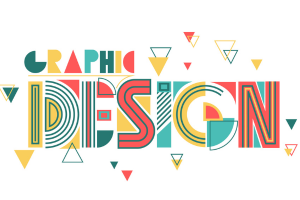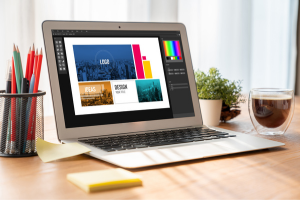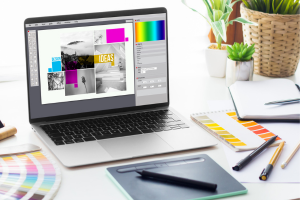In the fast-paced digital market today, branding becomes more than just a name- it is a promise, a reputation, and a whole experience. Behind each strong brand is a strong Logo and Brand Identity Design , the visual elements that are required to convey to the world what the company is all about in terms of values, mission, and personality.
An emerging or mature company must know what it is doing when it comes to logo or brand identity design. Within this guide, we will cover what brand identity means, how your logo fits into the whole picture, and the best practices in developing a cohesive and memorable visual identity.
What Is Brand Identity?
Brand identity refers to the visual as well as emotional representation of your brand. It covers everything, from logo to color palette and typography, tone of voice, brand story, and messaging.
It is the way your audience perceives your company at every touchpoint, as far as brand identity is concerned. The personality and values expressed by your brand are the means through which they are communicated visually as well as emotionally.
Components of Brand Identity :
Logo Design
Color Scheme
Typography
Imagery and Graphic Style
Tone of Voice
Brand Guidelines
The Role of Logo Design in Brand Identity
Your logo is your business face. It is usually the first thing people notice about and remember relating to your business. A good logo will set the mood for the entire brand identity and act a visual pathway to everything your brand stands for.
What Makes Great Logos?
Simplicity: easier to recognize, easier to remember
Relevance: Applicable to your industry, target audience, and brand values.
Scalable: It must look good on everything from business cards to billboards.
Unique: To set you apart from competitors.
Timelessness: It is valid regardless of changing trends.
The Connection Between Logo and Brand Identity
Your logo can be the last thing in the identity of the brand-but it is only part of the total picture, and the other parts can be compared as the iceberg tip. The iceberg tip floats out of the water and draws people into the piece of ice below the surface.
However, a strong identity in branding brings everything around the logo on point, from messaging and colors to typography. That way, the trust builds up in remembering the brand and through an increase in recognizability and emotional bond with the audience.
Steps to Creating a Strong Logo and Brand Identity Design
1. Define Your Brand Core
Have input on your brand before proceeding to design:
What is your mission?
What are your core values?
Whom do you want to serve?
What makes you different?
If you can answer these questions, you will have every answer you need for every design choice you make.
2. Research Your Industry and Competitors
Look around at branding similar to yours. What gaps are in the market? What elements of design have been played out? What opportunities are there to stand out?
3. Create the Brand Mood Board
Initial mood boards are made of any images, logos, colours, and even typefaces that champion the mood you wish to evoke for your brand. This will act as inspiration to create a visual roadmap for your brand identity.
4. Design the Logo
With the brand strategy in place:
Start sketching your ideas.
Proceed to digital mockups.
Try different color variations.
Check scalability and legibility.
Professional logo designers usually provide several versions: horizontal, vertical, icon-only, and black-and-white.
5. Choose Brand Colors and Typography
Colors evoke emotions. Fonts should be legible, but with your proper tone-modern, playful, serious, elegant, et cetera.
6. Create a Brand Style Guide
A brand style guide dictates its coherence across platforms. It typically includes:
Rules on the use of logos
Colors of the brand (by HEX, RGB, and CMYK codes)
Typography styles
Guidelines for imagery
Voice and tone
Best Practices for Logo and Brand Identity Design
Ensure consistency.
Consistency will lead to brand visibility. Every design item should have the same style and message, whether it is your site or business card.
Design with versatility in mind.
From prints to digital media, social to packaging, all the time, the logo and branding must look good on a variety of media, so the visual assets must be adaptable.
Evocative
Memorable designs are emotional; use color psychology and storytelling visuals to penetrate deeply into someone’s memory systems.
Keep It Simple and Clear
Don’t clutter. Clean, simple design is more effective and easily scalable between breaking devices and materials.
Test on all Platforms
Test your logo and visual identity on mobile devices, laptops, social media profiles, signage, and merchandise.
Common Mistakes to Avoid
Copying Competitors: Your identity should be original and true to your brand-not a clone of someone else’s.
Over-complicating the Logo: A logo becomes very difficult to read when it has too many colors or details.
Ignoring Audience Preferences: Your design should appeal to your target demographic, not just your taste.
Inconsistent Use: Customers get confused because of the use of different fonts, colors, or logo variations without having a clear guide through which they can understand what one’s brand is.
Examples of Great Logo and Brand Identity Design
Apple
Minimalistic and sleek, the logo represents modernism and elegance, reflective of the company’s innovative work. This renders a clean, modern, and consistent brand identity.
Nike
Most people around the world recognize Nike for the same design they used to make their mysterious name. The swoosh for Nike conveys motion and performance and perfectly fits the brand values.
Coca-Cola
Right from its typographical style to its classic red color, Coca-Cola’s brand identity resonates timelessly and awakens within consumers strong emotional ties with the company.
Why Invest in Professional Logo and Brand Identity Design?
A professional Logo and Brand Identity Design assures that branding does the following:
Reflects a unique value proposition
Builds trust and credibility
Enhances customer retention
Improves brand recognition
Supports long-term marketing efforts
Maploon.com is the best option if you want a personalized service in developing and Brand Identity Design based on your business goal and target audience.
Conclusion
Not just how pretty they are, Logo and Brand Identity Design Design say something about your story, build trust, and createsa lasting connection with the audience. In a highly competitive environment, you want versatility and coherence to differentiate between having a unique visual identity and blending in.
Invest in the time, research, and ideas to craft a brand identity in line with your values and vision. Launching a brand for the first time or running through a rebranding cycle: this is crucial. Your brand identity is the soul of your business in visual form- make it unforgettable in your audience’s memory.






